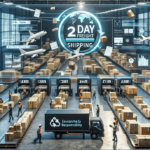Why Offering 2-Day Shipping is Crucial for Your Business
In the highly competitive e-commerce landscape, providing 2-day shipping is no longer a luxury but a necessity. Customers increasingly expect rapid delivery times, with 2-day shipping becoming a standard offering among top retailers. According to a Business Insider report, 67% of online shoppers consider fast shipping as a key factor in their purchasing decisions.
Offering expedited shipping options not only meets customer expectations but also fosters higher customer satisfaction and loyalty. Studies have shown that customers are willing to pay a premium for faster delivery, which can lead to increased average order values and repeat business.
Moreover, 2-day shipping can significantly decrease cart abandonment rates. Quick and predictable delivery timelines reduce uncertainty and encourage customers to complete their purchases, thereby boosting overall sales.
Understanding and Managing Shipping Costs
Breakdown of 2-Day Shipping Costs
Implementing 2-day shipping involves several cost components, including transportation fees, packaging materials, labor, and administrative expenses. These costs can vary based on the size and weight of the products, shipping distance, and volume of orders.
Balancing Costs with Customer Expectations
While 2-day shipping can be costly, the potential benefits often outweigh the expenses. Enhanced customer satisfaction and increased sales can offset the higher shipping costs. It's essential to analyze your business's shipping volume and negotiate rates with carriers to manage these costs effectively.
Strategies for Reducing 2-Day Shipping Expenses
Negotiating with Shipping Carriers
One of the most effective ways to reduce shipping costs is by negotiating better rates with carriers. Businesses that ship in large volumes can leverage their shipping volumes to secure discounts and more favorable terms. According to the Harvard Business Review, negotiating with multiple carriers can also lead to competitive pricing.
Optimizing Packaging Solutions
Choosing the right packaging can significantly reduce shipping costs. Lightweight and compact packaging not only lowers transportation fees but also minimizes the risk of product damage. Additionally, using sustainable packaging can appeal to environmentally conscious consumers and potentially reduce costs through bulk purchasing.
Consolidating Shipments
Consolidating multiple orders destined for the same location can help take advantage of volume discounts and reduce the per-unit shipping cost. Implementing efficient order processing systems ensures that shipments are grouped effectively without delaying delivery times.
Enhancing Shipping Operations for Efficiency
Leveraging Technology and Automation
Investing in automation tools for order processing, label printing, and inventory management can streamline shipping operations and reduce labor costs. Automated systems ensure accuracy and speed, which are critical for maintaining 2-day delivery promises.
Implementing Real-Time Tracking
Providing real-time tracking information to customers enhances transparency and trust. According to a Statista survey, 85% of online shoppers want detailed updates on their order status. Real-time tracking can also reduce customer service inquiries related to order status.
Optimizing Warehouse Locations
Strategically locating warehouses closer to major customer bases can reduce delivery times and transportation costs. This geographical optimization ensures that 2-day shipping is feasible and cost-effective.
Ensuring Customer Satisfaction in 2-Day Shipping
Clear Communication and Transparency
Transparent communication regarding shipping times, costs, and policies is essential. Clearly stating your 2-day shipping options during the checkout process helps set accurate customer expectations and reduces potential misunderstandings.
Handling Returns and Exchanges Efficiently
A seamless returns and exchanges process enhances customer trust and satisfaction. Providing pre-paid shipping labels and quick turnaround times for returns can make the purchasing experience more positive, encouraging repeat business.
Exceptional Customer Service
Offering responsive and helpful customer service ensures that any issues related to shipping are resolved promptly. According to Forbes, businesses with exceptional customer service see higher customer retention rates.
Common Mistakes and Best Practices
Common Mistakes to Avoid
- Overpromising Delivery Times and Under-delivering
- Neglecting to Optimize Packaging
- Failing to Negotiate Shipping Rates
- Ignoring Customer Feedback on Shipping Experience
Best Practices for Successful 2-Day Shipping
- Continuously Monitor and Optimize Shipping Processes
- Invest in Reliable Shipping Partners
- Use Data Analytics to Predict and Manage Shipping Demand
- Enhance the User Experience with Seamless Tracking
Future Trends and Case Studies in 2-Day Shipping
Future Trends in E-commerce Shipping
- Increased Use of Automation and AI in Logistics
- Expansion of Drone and Autonomous Vehicle Deliveries
- Growth of Same-Day and Faster Shipping Options
- Enhanced Focus on Sustainable and Eco-friendly Shipping Practices
Successful Case Studies
Companies like Amazon Prime have set the benchmark for 2-day shipping, driving customer loyalty and sales growth. Similarly, retailers such as Walmart and Target have successfully integrated rapid delivery options to remain competitive in the e-commerce space.
Conclusion: The Critical Role of Affordable 2-Day Shipping in Business Success
Investing in affordable 2-day shipping is essential for businesses aiming to thrive in the competitive e-commerce market. By understanding and managing shipping costs, implementing effective strategies, optimizing operations, and ensuring exceptional customer satisfaction, businesses can leverage 2-day shipping to attract and retain customers. Staying abreast of future shipping trends and learning from successful case studies further positions businesses for long-term success in the evolving market.






















